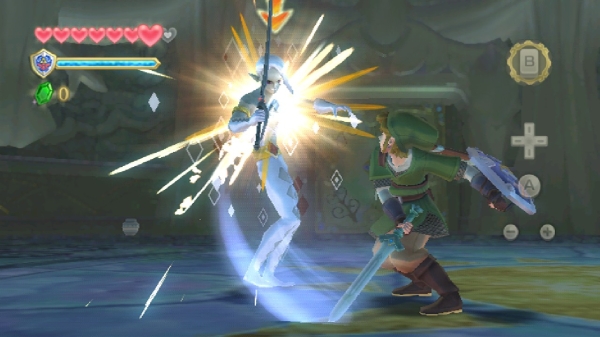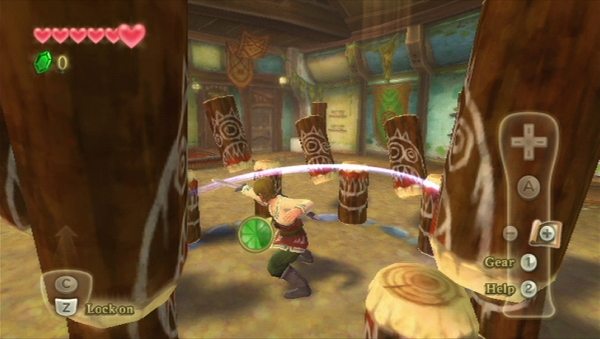
2011 was definitely the Year of Zelda. The franchise celebrated its 25th anniversary with symphonies, re-releases of previous Zelda games on handhelds, a swanky display in the Nintendo World Store in New York City, and the release of The Legend of Zelda: Skyward Sword. It is the first true console Zelda game since The Legend of Zelda: Twilight Princess and was promised to take full advantage of the Wii’s capabilities. With the addition of the Wii MotionPlus support, does Skyward Sword live up to all of the hype? Or will we wish to play the Song of Time and be whisked away to an era of better Zelda games?
Platforms: Wii
Publisher: Nintendo
Developer: Nintendo EAD, Monolith Soft
Genre: Hylian Nintendo Sports Games Compilation
Release Date: November 20, 2011
ESRB Rating: Everyone 10+
Are you a Wii owner? If so, you need to buy this game. Don’t have a Wii? Buy one, borrow one, or just somehow legally acquire one so you can play this game. Skyward Sword is the culmination of everything Nintendo has learned during the last five years of making games for the Wii. While the experience isn’t totally perfect, it is one of the most enjoyable games on the console and would fittingly make for a swan song before the Wii U’s emergence. The graphics are aesthetically impressive, the music is played by an orchestra for the first time, the controls are somewhat problematic but enjoyable for the most part, and the narrative is deep, answering a lot of questions for longtime Zelda fans.
Given the technical limitations of the Wii, one shouldn’t expect to see eye-melting detail in Skyward Sword. You won’t be playing the game in 1080p and inspecting Link’s pores. But with that said, the graphics in the game are actually very pleasant and engaging. The backgrounds blend colors in such a way to evoke an impressionist style painting. It’s as if Henri Matisse and Claude Monet stepped in to help create the land of Hyrule. The character models themselves are interesting, and are typical quality for a Zelda game. Each NPC has a unique look and personality, complete with changing facial expressions and animations. The cutscenes are more cinematic in this title and help bring more drama to the story.
The environments are varied and feature details that make each location distinct. The Faron Woods are lush with greens, vines, trees, and mushrooms. The Lanayru Desert is sandy and dry, with heat rippling the air. The Eldin Volcano region is rocky, full of lava, and has very little vegetation. All of these areas are a joy to explore and are pretty memorable; which is good, because there is some backtracking to be done and you’ll need to know the lay of the land.

I knew my ears were in for a treat when it was announced that Skyward Sword would be fully orchestrated. Though the music does not have the staying power of previous titles’ more iconic themes, it serves the game well and helps set the mood for Link’s first epic adventure. There were a few instances in which I felt an actual adrenaline rush during normal battles because of the music. There’s nothing quite like diving off a bird and into the clouds while adventurous music swells.
The controls are my biggest issue with this game. I would have given Skyward a perfect score if it weren’t for some minor gripes with the motion controls and how they’re required for just about everything Link does. The Wii MotionPlus is not as 1:1 as I would have hoped in terms of movement ratio. When you’re cutting grass or going berserk on bamboo, it’s not really an issue. But when you’re surrounded by enemies who need to be defeated with slashes at certain angles, it gets to be a little annoying. The one move that threatened to break my wrist because of the number of attempts it took was the thrust. You have to hold the WiiMote in just the right way while thrusting forward so it doesn’t end up in a blocked slash.
Quick shots with the Bow are also sometimes troublesome because it doesn’t always register when you move the Nunchuk back, as if you were drawing a bowstring. I appreciate what they tried to do, but I just wish the controls were tighter so I could wield Link’s tools as effectively as he did in previous games.
Not all of the controls were as frustrating and some tools were actually fun to use. The Beetle, which is a new wrist-mounted gadget that Link can launch and control remotely, proved to be the most useful tool. It is easy to fly around obstacles in the environment and can even be upgraded to grab rupees, hearts, and bombs that are out of reach. The bombs can be rolled like bowling balls in Wii Sports, complete with spins. The Double Claw Shot is probably the easiest to use, with its point and shoot mechanic. It is just a shame that you can’t use the Whip as an actual weapon. I would have loved to roam around pretending Link was a Belmont.

But Link is not a Belmont; he is the Goddess’s Chosen Hero. And in Skyward Sword, we witness the very first adventure in the Legend of Zelda timeline. The narrative is deeper than most of the other Zelda titles, which is understandable because this is an origin story of sorts. Without giving too much away, I can say that Skyward establishes some of the mainstays we’ve seen in the series and answers a lot of questions. This game’s iterations of Link and Zelda seemed to be more fleshed out than we’ve previously seen in other games. The childhood friend trope works here and is endearing because of Link and Zelda’s prominence in gaming’s cultural memory. Fi, the Autotuned spirit of the Goddess Sword, is by no means as annoying as Navi, but the way she describes everything in percentages is.
The supporting characters have a range of personalities and will often ask Link for assistance. These sidequests are optional, but aid in expanding the adventure as well as providing some humor to this epic tale. The bosses do their jobs but are ultimately forgettable, save for Demon Lord Ghirahim (affectionately nicknamed “Fabulous Debbie” by the Internet community).
The adventure can feel tedious at times due to some backtracking and a few boring puzzles here and there, but a lot of the action is grand and sweeping. You will devote many hours to completing this origin story and even more if you decide to hunt down collectables, upgrade everything, and complete all of the side quests. Skyward Sword now stands as my second favorite Zelda game, eclipsed only by The Legend of Zelda: Ocarina of Time. If it had better pacing and tighter controls, it would stand side by side with Ocarina. But as the latest console Zelda to come out since Twilight Princess, it proves to be an amazing adventure and is also the one that starts them all. Buy it. Own it. Love it.

Review Disclosure: A review copy of The Legend of Zelda: Skyward Sword was provided by Nintendo for the purposes of this review.







